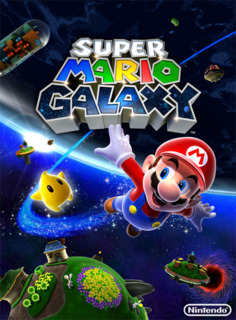Super Mario Galaxy is a 3D platform game developed and published by Nintendo EAD Tokyo and published by Nintendo for the
Mario running around a spherical planetoidMost of the game is set in outer space along a vast chain of planetoids and other space matter, though many levels consist of larger areas to explore such as the Beach Bowl Galaxy and Honeyhive Galaxy.
Mario is capable of jumping or launching from planet to planet in order to gather items and defeat enemies. Each planet has a gravitational force, which allows the player to circumnavigate rounded objects, walking sideways or upside down. Mario can transform into Fire Mario, Ice Mario, Bee Mario, Boo Mario, Spring Mario, Flying Mario, and Rainbow Mario. Like previous 3D Mario games, the main objective is to collect Stars, which are awarded by completing tasks or defeating enemies. The game's central hub is the Comet Observatory, which is divided into six themed areas: the Terrace, Fountain, Kitchen, Bedroom, Engine Room, and Garden. Distributed among these six worlds are 42 galaxies, or levels, with 1 to 7 stars each.[1] Obtaining these stars allows the player to unlock more in each themed galaxy. There are a total of 121 stars in the game, with the 121st star only available after collecting the first 120 with both Mario and then Luigi.
Mario traveling from one planetoid to anotherMario has a range of jumping abilities, including his trademark triple jump and wall kick and moves that were absent in Super Mario Sunshine, like the long jump. He can also perform flips by immediately turning and jumping, and do a ground-pound move to smash breakable objects or enemies below. Mario's melee move is a spin, executed by shaking the Wii Remote or Nunchuk, which allows him to attack enemies, break objects, and activate Launch Stars and Sling Stars that shoot him across the galaxy. The Wii Remote's motion sensing is used to 'steer' a manta ray and balance on a rolling ball. The pointer allows the player to direct wind when riding a bubble, activate Pull Stars that pull Mario to planets, and collect, aim, and fire Star Bits.
As in every 3D Mario game, Mario's health consists of a power meter, which can be restored by collecting coins, but when it reaches zero, Mario loses a life. Mario begins with a power meter made of three sections, but when players collect a Life Mushroom, his meter is expanded by three to a maximum of six health bars. However, this power-up is not permanent, since causing it to drop to 3 will revert the maximum to 3. Mario also has a second and separate health meter that designates his air supply when swimming underwater; if it is empty Mario will quickly lose parts of his power meter. The bottomless pits featured in previous Mario games that cost Mario a life when fallen in have been replaced by black holes, which are stationed beneath the surfaces of certain planets and spread throughout space (though sometimes when Mario is outside of the gravitational pull of a planet, he will fall in traditional fashion).
[edit] Environmental mechanics
New gameplay mechanics include Gravity Arrows, which make Mario gravitate in the direction that these arrows point, and Star Bits, which can be grabbed simply by moving the cursor over them.[2] For every 50 Star Bits he collects, Mario will be rewarded with an extra life, similar to how collecting 100 coins resulted in an extra life in the other games. He can fire Star Bits to stun enemies or spawn coins from some places or objects like sprouts, which bloom when struck with Star Bits. The Star Bits, which resemble the Japanese confection konpeito, can be used to feed Hungry Lumas that appear within the observatory and galaxies.[3] When they are full, they form a new planet or galaxy in which an additional star can be found.
There are five types of Prankster Comets that appear randomly (The Speedy, Daredevil, Cosmic, Fast-Foe, and Purple comets); when one of them comes into contact with a level, a special challenge is initiated that leads to a Power Star.[4]
Mario in the Bee Suit, a new power-up for the game.Super Mario Galaxy features the most power-ups and transformations of any 3D Mario game to date.[5] Mario has the ability to transform into a bee and a Boo using different suits. The Boo suit makes him invisible and the bee suit allows him to fly and hover for a short time. Flowers are also present; fire flowers work the same as in 2-D games (apart from a 20-second time limit) and ice flowers let Mario freeze water and lava to walk or skate on it. The Spring Shroom lets Mario jump very high. The Red Star allows Mario to fly around freely for a short time, similar to the Wing Cap from Super Mario 64. The Rainbow Star makes you invincible.
The game offers six save files and the option of using Miis from the Mii Channel.[6]
[edit] Multiplayer
Super Mario Galaxy has a co-operative two-player option called "Co-Star Mode", in which one player controls Mario and a star pointer while the other controls another pointer on-screen to gather Star Bits and shoot them at enemies.[7] While the first player can normally do this except during certain events, the second player can shoot stars without restriction. The second player also is more efficient in manipulating the environment, such as halting object and enemy movement. Some obstacles, when halted by the second player, are automatically destroyed. Additionally, the height of Mario's jump can be increased if the first and second player press the A button at the same moment. Because of these added abilities, especially the ability to stun enemies, Co-Star Mode is less difficult than single-player mode

